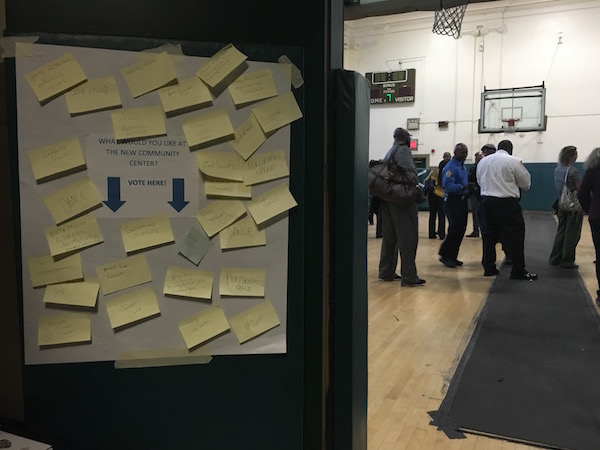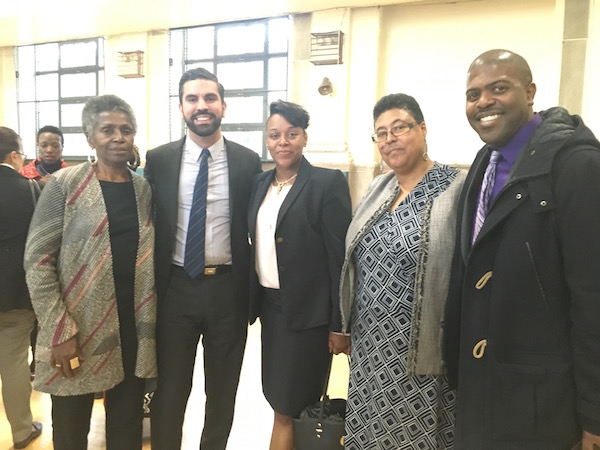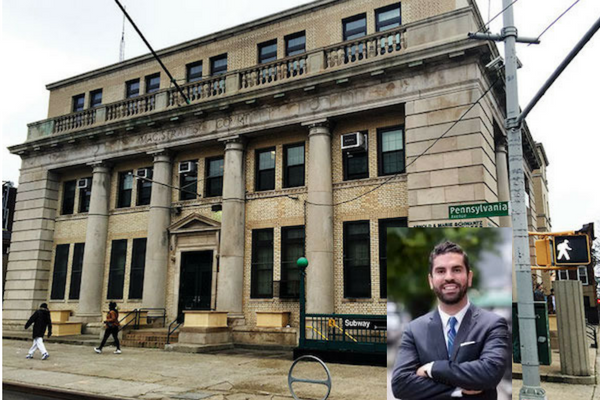
The fruit of City Council Member Rafael Espinal Jr.‘s ability as a horse trader is starting to pay off.
That after the East New York/Bushwick lawmaker led a group of police and city officials along with East New York residents on a visioning tour of the neighborhood’s future 19,000 square foot community center – a former courthouse now being used by the NYPD for administrative space at 127 Pennsylvania Avenue between Liberty and Atlantic avenues.
And along the tour the residents left sticky notes full of ideas for each room. Among the top ideas were a “dance studio,” “boxing ring,” “computer lab,” and “advanced learning courses.”

“This space, which was once used to put people in jail, will now be used to keep people out of it,” said Espinal. “These doors will be open to everyone– our youth, adults, seniors, and all those in between– who deserve an accessible location where they can participate in fun activities and congregate recreationally to further strengthen our community. I am thrilled by the enthusiasm we saw here tonight, and look forward to these ideas coming into fruition.”
The funding for the center comes as part of the comprehensive East New York Neighborhood Plan that Espinal was able to secure in the Spring of 2016 with Mayor Bill de Blasio, who wanted the neighborhood as a cornerstone to his citywide Mandatory Inclusionary Housing (MIH) plan, which would allow for higher density development in exchange for more affordable housing.

In total, Espinal, with overwhelming City Council support, was able to get $250 million in allocated investments as part of signing off on the MIH plan.
Among the investments include:
Education:
-
$17.45 million to 27 existing public schools for tech and infrastructure upgrades (purchasing new laptops, smartboards and upgrading gym/auditorium/playground space, etc. based on the needs of the particular school and identifications made in conversation with Espinal’s office).
-
The City will build a new 1,000 seat school in District 19, to alleviate school overcrowding and provide for a growing population. The school will include an at-grade playground that will be open to the public during non-school hours.
TRANSPORTATION:
-
Transform Atlantic Avenue into a vibrant and safe corridor connecting residents on both sides of the street through a major street improvement project that will include a new raised, planted median, curb extensions at fifteen intersections, a complete road resurfacing, safer crosswalks, more than 100 new street trees, wayfinding signage and new sidewalks with public benches and bike racks. This project will advance Vision Zero for pedestrian safety while supporting more active uses along the Atlantic Avenue corridor.
-
Improve the streetscape around Broadway Junction station to make the area safer and improve the commuter experience at this major transit hub by widening sidewalks, adding new vendor kiosks, new seating, landscaping and dedicated bus lanes. (THIS PROJECT IS NEARLY COMPLETED AND WILL HAVE A RIBBON CUTTING SOON)
-
Facilitate access to broadband internet by investing in conduit infrastructure along Atlantic Avenue. LinkNYC will also be deployed along two key corridors in East New York, providing free public Wi-Fi.
PARKS & RECREATION:
-
Renovate Callahan-Kelly Playground, located adjacent to the transit hub at Broadway Junction, to offer more diverse recreational options for residents of the surrounding neighborhoods of Ocean Hill, Brownsville, East New York and Bushwick.
-
Make upgrades to Highland Park to strengthen regional open space resource
-
Open new Schoolyards to Playground sites at PS 677-East Elementary School of Excellence and PS 345-Patrolman Robert Bolden, which will allow community use after school hours and on weekends.
As for the community center building, it was originally built in the 1920s. Then, in the 1960s it got taken up by the NYPD and used as an NYPD processing center. It was also used as a Police Athletic League (PAL) building and offered programming to kids run by the NYPD. Community Board 5 also rented out part of the building for their offices.
However, most of the building was dedicated to the NYPD with over 17,000 of the available 19,00 square feet dedicated to police processing and only about 2,000 for the community. Under the new plan, 13,000 will be for NYPD led community center activities and only 6,000 square feet for NYPD offices, such as for the Community Affairs Unit.






